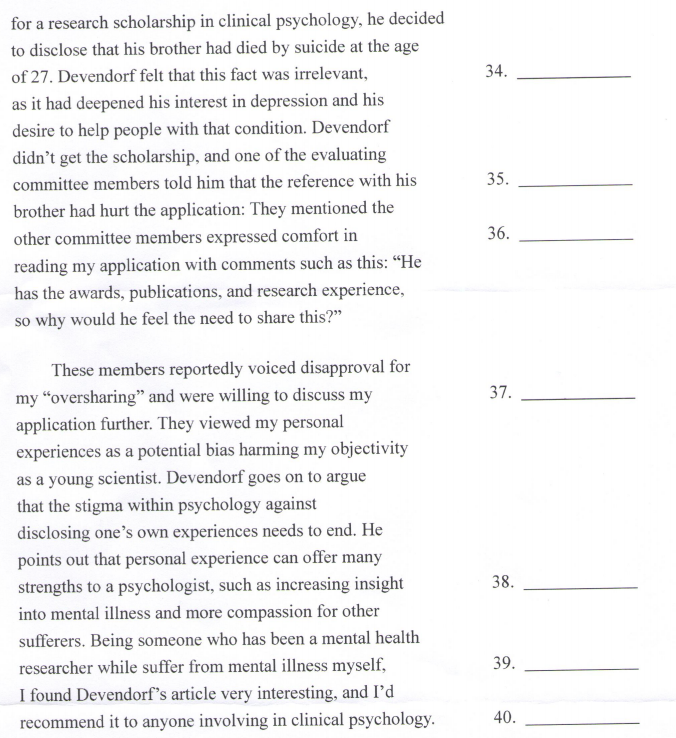中国海洋大学2021年硕士研究生招生考试试题
科目代码:211 科目名称:翻译硕士英语
Part I. Vocabulary and Grammar
Directions: There are twenty incomplete sentences in this part. Beneath each sentence there are four choices marked A, B, C and D. Choose ONE answer that best completes the sentence. Then write your answers on the Answer Sheet.
In the 20th century, the invention of the cellphone the means for meeting the increased demand for communications in societies.
A. prevailed
B. alluded
C.provided
D. achieved
2. He criticized the repressive methods by the country's government.
A. facilitated
B. employed
C. exhausted
D. acquired
3. We are affected by what happens to us in childhood.
A. randomly
B. profoundly
C. cautiously
D. thoughtfully
4. They were planning to the seventy officials still in the country.
A.refute
B. exempt
C. evacuate
D. undermine
5. The materials have to be able to high temperatures.
A. withstand
B. uphold
C. embitter
D. suspend
6. With technological changes many traditional skills have become .
A. unmatched
B. obsolete
C. temporary
D. transitional
7. The of his evidence left serious room for doubt.
A. acclimatization
B. expenditure
C. redundancy
D. inconsistency
8.The President resigned amid considerable .
A. controversy
B. aptitude
C. contradiction
D. pretense
9. It is becoming clear that this problem will not be easily solved.
A. improbably
B. increasingly
C. instantaneously
D. reciprocally
10. Few buildings the war intact.
A. elevated
B. survived
C. revolved
D. suffocated
11. Distribution of the food is going ahead using a of local volunteers.
A. paradox
B. detachment
C.catalogue
D. network
12. This valve the flow of water.
A. interferes
B. discloses
C. regulates
D. allows
13. Working with such interesting people has been very .
A. irrelevant
B. stimulating
C. dull
D. reluctant
14. My grandmother, as usual, lamented the in moral standards in today's society.
A. consumption
B. decline
C. contingency
D. conviction
15. These are the courses available.
A. fruitfully
B. adequately
C. presently
D. notoriously
16. Anyway, you're here; you stay.
A. would like to
B. must better
C. will go and
D. might as well
17. for his family, He'd have gone away long ago.
A. Had it not been
B. If it had been
C. It wouldn't have been
D. If it were
18. He gripped his brother's arm he be trampled by the mob.
A. however
B. in order that
C. lest
D. no matter what
19. It did nothing make us ridiculous.
A. but
B. resulting from
C. besides
D. nevertheless
20.Choose the correct sentence.
A.The woman is Korean whose son you just talked with.
B.The woman you just talked with her son is Korean.
C.The woman whose Korean son you just talked with.
D.The woman whose son you just talked with is Korean.
Part II. Language Use
Section A: Banked Cloze
Directions: In this section, there is a passage with TEN blanks. You are required to select one word for each blank from a list of fifteen choices given in a word bank following the passage. Read the passage through carefully before making your choices. You may not use any of the words in the bank more than once.
agreement awakened dispute fragility irreversible
magnitude negatively poisonous positively proliferation
reached reversible scarcity stability unraveled
Biological diversity has become widely recognized as a critical conservation issue only in the past two decades. The rapid destruction of the tropical rain forests, which are the ecosystems with the highest known species diversity on Earth, has
21. people to the importance and 22. of biological diversity. The high rate of species extinctions in these environments is jolting, but it is important to recognize the significance of biological diversity in all ecosystems. As the human population continues to expand, it will 23. affect one after another of Earth's ecosystems. In terrestrial ecosystems and in fringe marine ecosystems (such as wetlands), the most common problem is habitat destruction. In most situations, the result is 24. . Now humans are beginning to destroy marine ecosystems through other types of activities, such as disposal and run off of 25. waste; in less than two centuries, by significantly reducing the variety of species on Earth, they have 26. cons of evolution and irrevocably redirected its course.
Certainly, there have been periods in Earth's history when mass extinctions have occurred. The extinction of the dinosaurs was caused by some physical event, either climatic or cosmic. There have also been less dramatic extinctions, as when natural competition between species 27. an extreme conclusion. Only 0.01 percent of the species that have lived on Earth have survived to the present, and it was largely chance that determined which species survived and which died out.
However, nothing has ever equaled the 28. and speed with which the human species is altering the physical and chemical world and demolishing the environment. In fact, there is wide 29. that it is the rate of change humans are inflicting, even more than the changes themselves, that will lead to biological devastation. Life on Earth has continually been in flux as slow physical and chemical changes have occurred on Earth, but life needs time to adapt 一 time for migration and genetic adaptation within existing species and time for the 30. of new genetic material and new species that may be able to survive in new environments.
Section B: Error Correction [10 points]
Directions: The following passage contains TEN errors. Each indicated line contains a maximum of ONE error. In each case, only ONE word is involved. You should proofread the passage and correct it in the following way.


Part III. Reading Comprehension
Section A: Multiple-Choice Questions
Directions: In this section there are four reading passages, with each followed by five multiple-choice questions. For each of them there are four choices marked A, B, C and D. Choose ONE answer that best answers the question or completes the statement.
Then write your answers on the Answer Sheet.
<Passage One>
In a study published on October 30 in Science, a group of geneticists, evolutionary biologists, and archaeologists study the ancient dogs' DNA. The study not only helps uncover the evolutionary history of dogs, but also provides some tantalizing clues about prehistoric human culture. It opens a window onto the close, millennia-long relationship between humans and their canine companions.
“It's another layer to the understanding of human history; says Anders Bergstrom, one of the paper's lead authors. "We can uncover historical processes between human populations that aren't necessarily visible in human DNA."
Dogs make for interesting research subjects, from both a biological and an anthropological perspective. Domesticated dogs, wolves, and dingos all belong to the same species, even though dogs diverged evolutionarily from wolves sometime between 15,000 and 40,000 years ago. Since that split, people have bred dogs into the genetically distinct populations that we call breeds. By comparing dog genomes, we can learn about the human-made processes that produced these populations一and by studying ancient dog genomes, we can work to understand what those processes looked like far into the past.
Ancient DNA research is always a group effort, and this paper is no exception: It has 56 authors. Some of these people are archaeologists一in sites as for apart as Spain and Siberia, they dug up the bones of the 27 dogs examined in this study, who lived between 11,000 and 100 years ago. Other authors are the scientists who labored over these ancient specimens to extract and sequence their genetic material. And still others, like Bergstrom, analyzed the data fbr evidence of the evolutionary relationships among these 27 dogs, modem dogs, and wolves.
Studying ancient DNA poses some major methodological challenges. DNA degrades over time, so it's difficult to be confident in any given A, C, T, or G in an ancient genome. So to analyze the dog genomes, Bergstrom and his colleagues used F-statistics, which compare the whole genomes of different specimens to one another in order to determine which pairs of animals are more or less closely related. "They tell you, with very few assumptions, that this specimen is closer to A than to B," Bergstrom says. "And, of course, that doesn't necessarily tell you what happened in terms of the historical process. But it tells you some basic facts about relationships." Scientists can then use this relational data to infer what the dog family tree must have looked like. Using this technique, the team was able to determine, for example, that ancient East Asian dogs are, surprisingly, more closely related to ancient European dogs than they are to ancient Middle Eastern dogs.
By building out this tree, Bergstrom and his colleagues discovered something surprising: 11,000 years ago, before many human groups had adopted agriculture, domesticated dog populations had already formed at least five genetically distinct groups. "At the end of the Ice Age, before any other animal had been domesticated, dogs had already branched out into separate lineages and spread out across the world," Bergstrom says. "A lot of these lineages are still represented today, in present-day dogs." In other words, breeds like today's Siberian huskies and German shepherds are descended from dog populations that were completely separate by around the year 9000 BC, if not earlier. uWe can look at dogs in a park, and we can see the result of this process that started already before any humans had started farming, or before any other animal had been domesticated, Bergstrom says.
This information isn't just interesting from an evolutionary perspective. It also provides a clue about how early humans related to dogs, long before they had formed close relationships with any other species of animal. Laurent Frantz, professor of paleogenomics at the Ludwig Maximilian University of Munich and the study's other lead author, believes that this discovery provides reason to think that hunter-gatherers may have deliberately bred dogs for certain traits. "Maybe artificial selection was already strong; he says. "And maybe it was already something conscious that people were doing."
So, while it may be difficult to learn about prehistoric dogs by studying their modern descendants, the special insights afforded by ancient DNA can provide invaluable context for understanding how humans relate to dogs today. uDogs are kind of unique in that they are a.predator, a carnivore. And they were domesticated by hunter-gatherers, way before agriculture, and they were also able to spread so quickly to most groups; Bergstrom says. Tt's somehow a surprisingly good fit for the human species to take on this animal as a companion—ven though, a priori, it seems like an unlikely candidate fbr domestication.”
If Bergstrom and his colleagues are right, the human tradition of living with, breeding, and protecting dogs, and of treating canines not just as useful tools but as sources of social connection and emotional support, could have an 11,000-year history. Even before they figured out how to cultivate crops, humans may very well have known how to take care of, and be taken care of by, their animals.
41.What does the word tantalizing in Paragraph 1 mean?
A.Vague.
B.Tempting.
C.Profound.
D.Agreeable.
42.Which of the following statements about the research findings is CORRECT?
A.Dogs were domesticated after human groups adopted the agriculture.
B.There were already several separate lineages of dogs 11,000 years ago.
C.Other animals had been domesticated before dogs were domesticated.
D.Many branches of ancient dogs cease to exist today.
43.What is the function of the F-statistics?
A.F-statistics can establish the relations among specimens.
B.F-statistics can tell the details of the evolutionary process of the dogs.
C.F-statistics can fix the degraded DNA.
D.F-statistics can show the family tree of the ancient dogs.
44.What can we learn from the last paragraph?
A.Theoretically speaking, dogs are difficult to be domesticated.
B.We can know much about the prehistoric dogs by studying modem dogs.
C.Dogs are domesticated because they are carnivore.
D.Dogs are treated only as useful tools 10,000 years ago.
45.What is the main idea of the passage?
A.Studying the genomes of ancient dogs provides clues for prehistoric human culture.
B.F-statistics are an important method of biology research.
C.Dogs are good companions to human beings.
D.The genomes of ancient dogs show that dogs are closely related to wolves.
相关推荐:
233考研交流QQ群:693804080
考研课程上新中!讲师坐镇,立即听课>>>
233考研题库,超多模拟题等你来刷,真题卷及时更新,立即查看>>>
加考研上岸君微信ks233wx21或扫码入群
超多干货福利随机掉落,志同道合小伙伴随时交流~ | 扫一扫二维码,关注233考研微信公众号
最新资讯第一时间知晓,备考经验技巧专栏传授 |











